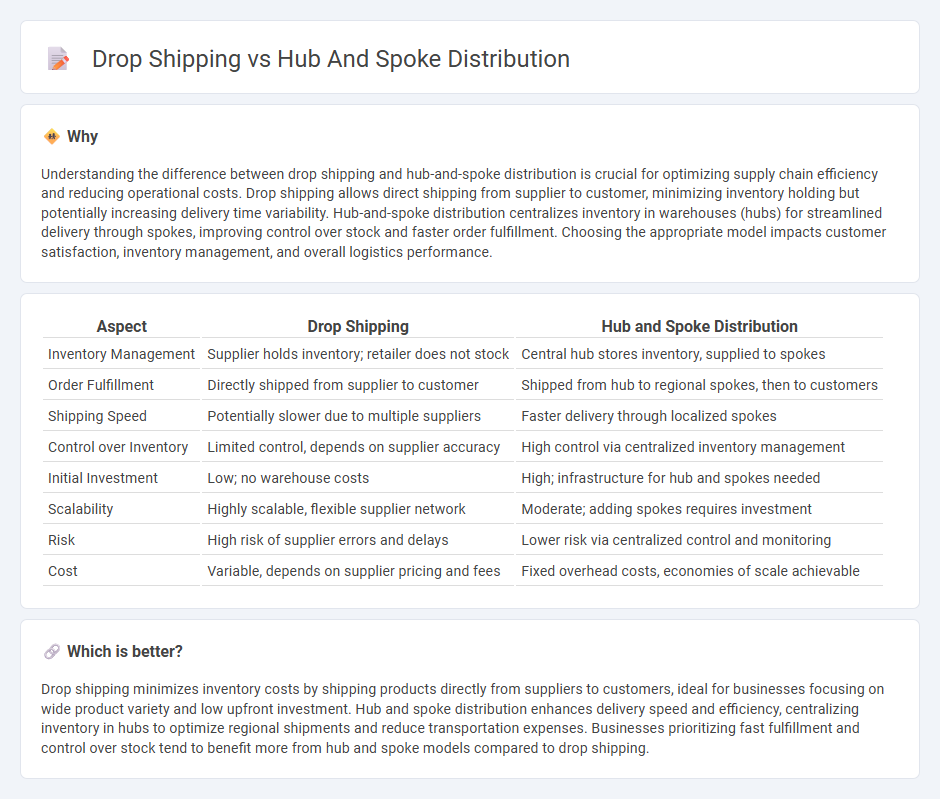
Drop shipping eliminates the need for inventory storage by shipping products directly from suppliers to customers, reducing upfront costs and delivery times. Hub and spoke distribution centralizes inventory in a central hub, which then distributes goods to regional spokes, optimizing delivery routes and inventory management. Discover more about how these logistics models can enhance your supply chain efficiency.
Why it is important
Understanding the difference between drop shipping and hub-and-spoke distribution is crucial for optimizing supply chain efficiency and reducing operational costs. Drop shipping allows direct shipping from supplier to customer, minimizing inventory holding but potentially increasing delivery time variability. Hub-and-spoke distribution centralizes inventory in warehouses (hubs) for streamlined delivery through spokes, improving control over stock and faster order fulfillment. Choosing the appropriate model impacts customer satisfaction, inventory management, and overall logistics performance.
Comparison Table
| Aspect | Drop Shipping | Hub and Spoke Distribution |
|---|---|---|
| Inventory Management | Supplier holds inventory; retailer does not stock | Central hub stores inventory, supplied to spokes |
| Order Fulfillment | Directly shipped from supplier to customer | Shipped from hub to regional spokes, then to customers |
| Shipping Speed | Potentially slower due to multiple suppliers | Faster delivery through localized spokes |
| Control over Inventory | Limited control, depends on supplier accuracy | High control via centralized inventory management |
| Initial Investment | Low; no warehouse costs | High; infrastructure for hub and spokes needed |
| Scalability | Highly scalable, flexible supplier network | Moderate; adding spokes requires investment |
| Risk | High risk of supplier errors and delays | Lower risk via centralized control and monitoring |
| Cost | Variable, depends on supplier pricing and fees | Fixed overhead costs, economies of scale achievable |
Which is better?
Drop shipping minimizes inventory costs by shipping products directly from suppliers to customers, ideal for businesses focusing on wide product variety and low upfront investment. Hub and spoke distribution enhances delivery speed and efficiency, centralizing inventory in hubs to optimize regional shipments and reduce transportation expenses. Businesses prioritizing fast fulfillment and control over stock tend to benefit more from hub and spoke models compared to drop shipping.
Connection
Drop shipping and hub and spoke distribution both streamline supply chain efficiency by minimizing inventory holding and centralizing order fulfillment. Drop shipping allows retailers to ship products directly from suppliers to customers, while hub and spoke distribution consolidates inventory at a central hub before dispersing to regional spokes or end destinations. This connection reduces delivery times and logistics costs, enhancing the overall responsiveness of e-commerce and retail supply chains.
Key Terms
Centralized Warehousing (Hub and Spoke)
Centralized warehousing in hub and spoke distribution optimizes inventory management by consolidating products in a central hub, facilitating efficient sorting and redistribution to regional spokes. This model reduces shipping times and lowers transportation costs compared to drop shipping, which relies on suppliers to ship directly to customers, often causing delays and inconsistent service quality. Explore more about how centralized warehousing enhances supply chain efficiency and customer satisfaction.
Last-Mile Delivery
Hub and spoke distribution centralizes inventory in regional hubs, allowing efficient last-mile delivery through spokes that connect directly to end customers, reducing delivery times and transportation costs. Drop shipping eliminates the need for inventory storage by shipping products directly from suppliers to customers, which can extend delivery times and complicate last-mile logistics due to multiple fulfillment points. Explore our detailed comparison to understand how these models impact last-mile delivery efficiency and customer satisfaction.
Direct Fulfillment (Drop Shipping)
Direct Fulfillment, commonly known as Drop Shipping, eliminates the need for inventory storage by shipping products directly from suppliers to customers, enhancing operational efficiency and reducing overhead costs. This method contrasts with the hub and spoke distribution model, which relies on central warehouses and multiple distribution points to manage inventory and fulfill orders. Explore how Direct Fulfillment streamlines supply chain management and boosts customer satisfaction by discovering its benefits and implementation strategies.
Source and External Links
The Hub and Spoke Distribution Model for SMB's - Ware2Go - This article explains the four-step process to implement a hub-and-spoke distribution system, focusing on selecting a central hub, establishing spoke networks based on regional demand, deploying technology for coordination, and partnering with on-demand warehousing to optimize the network.
Hub and Spoke Distribution Model: A Logistics Guide - Locus - Describes the hub and spoke model as a centralized logistics system with a main hub and multiple spokes resembling a bicycle wheel, enhancing delivery efficiency by centralizing inventory and optimizing shipment routes to cover multiple delivery locations effectively.
What Is The Hub And Spoke Distribution Model? - Explains that the hub and spoke logistics model centers on a hub distribution center and outward spoke routes to optimize delivery, reduce transit times, and enable scalable, regionally adaptive distribution strategies for meeting customer expectations like same-day or two-day delivery.
 dowidth.com
dowidth.com